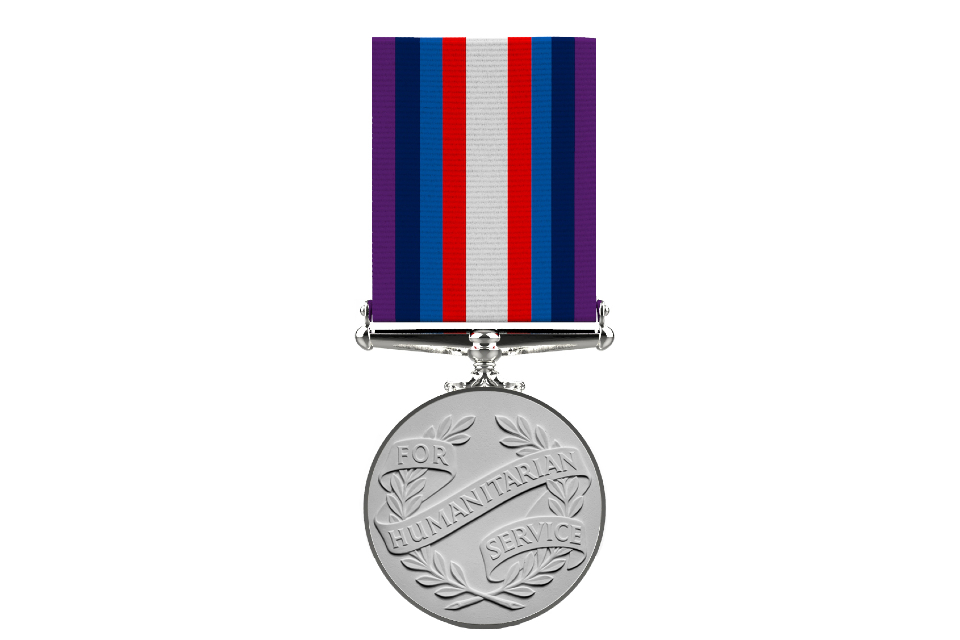New Humanitarian Medal announced
The introduction of a new Humanitarian Medal has been announced in The Gazette. The Humanitarian Medal will be awarded for service in support of human welfare during or in the aftermath of a crisis.

What is the Humanitarian Medal?
Announced in The Gazette (Gazette issue 64138), the Humanitarian Medal will be awarded to those in public service and members of organisations that contribute on behalf of HM Government, such as charities, which respond in support of human welfare during or in the aftermath of a crisis - for example, in combating a life-threatening crisis by providing disaster relief or aid provision, whether in hazardous circumstances such as conflict zones, both in the UK and internationally.
The type of service given must focus on humanitarian crisis rather than more broadly humanitarian welfare (response rather than the recovery) and must be in line with humanitarian principles in a domestic and international context.
The Humanitarian Medal will only be awarded to serious (level 2) or catastrophic (level 3) emergencies:
- Serious Emergency (Level 2) - One which has, or threatens, a wide and/or prolonged impact requiring sustained central government coordination and support from a number of departments and agencies, usually including the regional tier in England and where appropriate, the devolved administrations. The central government response to such an emergency would be coordinated from the Cabinet Office Briefing Rooms (COBR), under the leadership of the lead government department.
- Catastrophic Emergency (Level 3) - One which has an exceptionally high and potentially widespread impact and requires immediate central government direction and support. Characteristics might include a top-down response in circumstances where the local response had been overwhelmed, or the use of emergency powers were required.
Who can receive the Humanitarian Medal?
There is no public nomination process for the Humanitarian Medal. Government departments will be responsible for developing a case for the Committee on the Grant of Honours, Decorations and Medals (the policy committee for the honours system), following which a recommendation may be made to His Majesty The King for the Medal to be awarded. A clasp will be used to designate each use of the Medal.
Individuals
All qualifying service must be either:
- Frontline service - eligible recipients must have had direct contact with those whom they seek to assist, that is, the affected group or population.
- People-facing - service must focus on human welfare, a primary emphasis on people will always be essential. Service to preserve institutions etc can be considered via other forms of recognition.
- In direct support of the affected population - those operating with rigour to deliver operational effect which directly influences or impacts on the operational area without being subject to direct personal risk.
Qualifying service should include at least one of the following:
- Hazardous service - Conditions which are unsafe (war zones, areas affected by natural disasters); insecure (threats to life, whether natural, biological or human); rapidly changing; or at heightened risk (from ongoing natural disasters, increased exposure to potential harm).
- Sustained service - People who gave a long-term frontline service in response to the emergency of which conditions were on-going rather than immediate.
- Significant service - Persons who contributed in direct response to the emergency, assisted with the protection of lives and property and performed extraordinarily. This may be shorter in duration but characterised by a particularly serious immediate threat to life.
Organisations
Organisations eligible for the medal will have been deployed on behalf of, formally funded by or formally endorsed by HM Government. Organisations such as charities that attend an incident uninvited by HM Government will not be eligible.
Posthumous
The Humanitarian Medal can be awarded posthumously when one or more of the following applies:
- an individual would otherwise meet the eligibility criteria for a specific clasp
- an individual’s death is directly attributable or as a result of their humanitarian service
Who does the Humanitarian Medal look like?
The Humanitarian Medal design presents laurel wreaths symbolising victory in overcoming a crisis, interwoven with a banner proclaiming “For humanitarian service”. The obverse of the medal will bear the effigy of the Sovereign.
The ribbon design reflects the different paths for humanitarian service and the variety of services involved in such responses. The ribbon has a central stripe of white to represent civilians and peace, with four narrow stripes on either side of red, light blue, dark blue and purple. Red represents humanitarian organisations and light blue the NHS. Dark blue and purple represent the other services.
See also
The King's Birthday Honours list 2023
British armed forces promotions and awards in The Gazette
Coronation Medal to be awarded to Armed Forces and frontline workers
MOD unveils new medal to honour Kabul evacuation heroes
Find out more
The Humanitarian Medal - Command Paper (GOV.UK)
Images
GOV.UK
Publication date
30 August 2023
Any opinion expressed in this article is that of the author and the author alone, and does not necessarily represent that of The Gazette.
